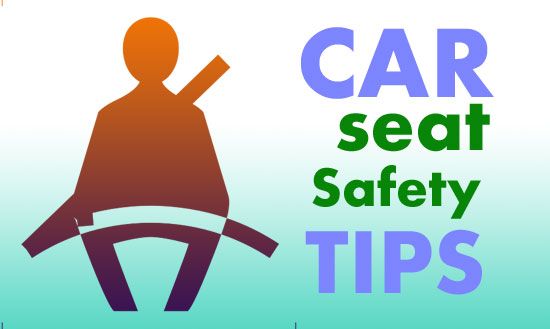Buckle Up Right: Crucial Tips for Car Seat Safety
Ensure the safety of your child with these car seat tips. Choose the right seat for their age and size, install it correctly, and register it for recalls. Keep infants rear-facing, use harnesses properly, and transition to booster seats when appropriate. Regularly check and follow the car seat guidelines for a secure and protected journey.

Choose the Right Seat:
Select a car seat appropriate for your child’s age, weight, and height. Use a rear-facing seat for infants and toddlers until they reach the recommended criteria for a forward-facing seat.
- Select a car seat appropriate for your child’s age, weight, and height.
- Use a rear-facing seat for infants and toddlers until they meet the recommended criteria for a forward-facing seat.
- Follow the manufacturer’s guidelines for installation and usage.
Install the Seat Correctly:
Ensure the car seat is securely and correctly installed in your vehicle. Follow the vehicle owner’s manual and car seat instructions for proper installation.
- Ensure the car seat is securely and correctly installed in your vehicle.
- Follow the vehicle owner’s manual and car seat instructions for proper installation.
- Check for a tight fit by trying to move the seat at the base; it should not move more than an inch in any direction.
Position the Straps Properly:
Adjust the harness straps to fit snugly. The straps should be at or below the child’s shoulders for rear-facing seats and at or above for forward-facing seats.
- Adjust the harness straps to fit snugly around the child.
- The straps should be at or below the child’s shoulders for rear-facing seats and at or above for forward-facing seats.
- Ensure the chest clip is positioned at armpit level.
Keep the Seat Rear-Facing:
Keep your child in a rear-facing car seat for as long as possible, following the manufacturer’s height and weight recommendations. It provides better head and neck protection.
- Keep your child in a rear-facing car seat for as long as possible, following the manufacturer’s height and weight recommendations.
- Rear-facing seats provide better head and neck protection in the event of a crash.
- Transition to a forward-facing seat only when your child has outgrown the rear-facing seat’s limits.
Use Booster Seats When Needed:
Transition to a booster seat when your child has outgrown the forward-facing seat. Ensure the vehicle’s lap and shoulder belts fit properly for added safety.
- Transition to a booster seat when your child has outgrown the forward-facing seat.
- Ensure the vehicle’s lap and shoulder belts fit properly, with the lap belt low on the hips and the shoulder belt across the chest.
- Keep your child in a booster seat until they meet the height and age requirements for using the vehicle’s seat belt alone.
Regularly Check and Update:
Regularly inspect the car seat for any signs of wear or damage. Stay informed about recalls and update to a new seat when your child outgrows the current one.
- Regularly inspect the car seat for any signs of wear or damage.
- Stay informed about recalls and update to a new seat when your child outgrows the current one or when necessary.
- Dispose of old or expired car seats properly and follow recycling guidelines.
Car seat safety tips: Being a family member, you are certainly spend a lot of time in the car, roaming from play dates to soccer matches, from the daily grocery store to Grandpa’s home and return again. Here are some tips to make sure you and your child is safe during these many safety tips:
- Safety experts advise that children should ride rearward-facing in the car until they are two years old or till they reach either the height or weight limit of their rear facing child safety seat.
- Child carriers are only used rearward-facing in the car. Changeable child seats can be used either rear-facing or forward-facing in the car. Changeable child seats often have a higher weight limit in the rear-facing direction than child carriers do,
so they can be used rear-facing by the children who have outgrown their child carrier, but are still less than two years old. Infants should remain rear-facing till they reach the highest weight or height allowed by their adaptable infant seat.
– Car seat safety tips
- Never set a rearward-facing child seat in front of a traveler air bag.
- Your children who are at least two years old or who have outgrown, their rearward-facing adaptable child seat can ride forward-facing in the car.
- All of your children whose height or weight is above the forward-facing limit for the child seat should use a belt positioning jab seat until the car’s seat belts fit properly.
- Please note that after outgrowing a inoculation seat, family members under age 13 should always use a seat belt and ride in the back seat.
- Used or old child safety seats should not be used except you are certain they have never been in a collapse and you have all the parts including instructions.
- Read carefully both the vehicle owner’s manual and the directions that come with the child safety seat.
- Also pls note that the best child safety seat is the one that correctly fits your child, the car and is used correctly each and every time.
- Always check your child safety seat before ride! for Car seat safety tips
Rear facing car seat rules
Changes ar being created to the burden and height at that a baby are going to be allowed to use a backless booster seat. However, oldsters won’t got to replace automotive seats they need already bought as a result of they will still use them.
Many kid seat consultants say they’re unsuitable for tiny youngsters because the kid isn’t control as firmly within the seat, the adult seatbelt isn’t radio-controlled across their body within the best approach and that they supply very little protection if a automotive is concerned in an exceedingly side-on crash. Rear facing car seat rules
Safest place for car seat
One of the foremost vital jobs you’ve got as a parent is keeping your kid safe once riding in an exceedingly vehicle. Each year, thousands of young youngsters ar killed or injured in automotive crashes. correct use of automotive seats helps keep youngsters safe. however with such a lot of completely different seats on the market, several oldsters realize this overwhelming. Car seat safety tips.
The safest place to ride for all youngsters younger than thirteen years is that the back seat. If attainable, it should be best to ride within the middle of the rear seat. Car seat safety tips – However, it’s typically troublesome to, put in a seat tightly within the middle if the vehicle seat is slim or uneven.
Also, most vehicles don’t have lower anchors for the center seating position. it’s safest to place, the seat in an exceedingly position wherever you’ll be able to install it tightly, with either the lower anchor system or seat belt; in some cases, this might get on either facet of the rear seat instead of the center. a baby traveller safety technician (CPST) will assist you decide that place is best to put in your child’s seat in your vehicle. safest place for car seat
Car seat safety tips from an expert
LATCH is confusing. It stands for Lower Anchors and Tethers for youngsters. LATCH is comprised of each elements on the seat, and elements within the vehicle, Baer explains. the govt. needs all vehicles model year 2003, and newer within the U.S. to possess a minimum of 2 seating positions with lower anchors and a minimum of 3 positions with tether anchors.
The lower anchors ar meant to switch the employment of the vehicle’s safety harness. Most automotive seats (not booster seats, however actual seats that have a five-point harness system) is secured to the lower anchors in vehicles by victimisation the LATCH belt on the child’s, automotive Car seat safety.
Speaking of that, {be sure|make certain|make sure|take automotivee} to place lots of thought into borrowed or hand-me-down car seats. you must ne’er get a second hand seat on-line.
If you are going to, share with friends or use it for over one kid, babe seats that ar in condition ar higher candidates for sharing than convertible automotive seats or boosters, that ar used for extended and usually expertise a lot of wear and tear. Car seat safety tips from an expert
Safest seat in a car
Using a seat (child safety seat) is that the best thanks to shield youngsters once traveling by automotive. each state. within the us needs that Associate in Nursing babe or tiny kid be restrained. And with sensible reason. — unintentional injury is that the leading explanation for death in youngsters, and most such injuries ar from automobile crashes. Car seat safety tips
The best seat isn’t forever the foremost high-priced one — it is the one that most closely fits a child’s weight, size, and age, also as your vehicle. Once you decide on a seat, make certain to do it out, keeping in mind that store displays and illustrations won’t show the right usage. It’s up to you to find out the way to install a automotive safety seat properly and harness your kid for the ride. safest seat in a car
[bws_related_posts]







